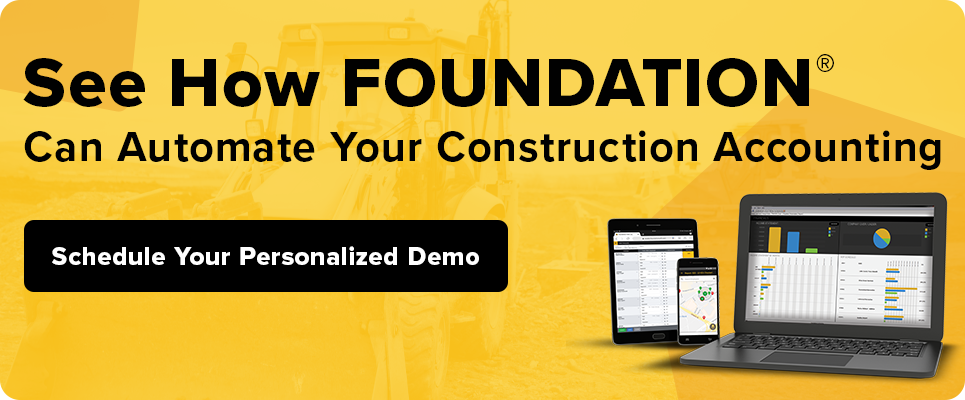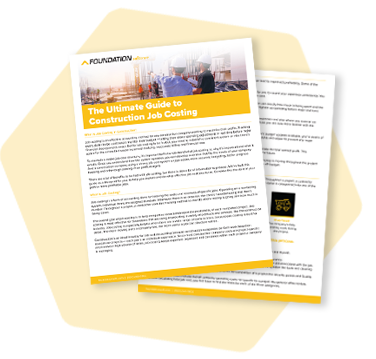
Why do we say cash is king? It’s one of the most powerful assets in your company, because it sets the reality for your business every day of your project cycle — not just at year-end when your financials tie out. That’s why it’s always critical for contractors to go beyond high-level financial statements and look at the different angles offered by company-wide and job-level cash flow reporting.

Why Cash is Different
Think of cash as the lifeblood of construction projects. In a medical exam, there are numerous tests your doctor will want to run. Some are routine; some are based on specific risk factors. All of them can be important. But none of them count for much if the heart isn’t working properly and carrying life throughout the body.
The Balance Sheet.
One of those basic, essential health checks for any business is the balance sheet. The balance sheet looks at a specified moment in your fiscal year. It represents the balance of your resources that have value (“assets”) and your resources owed (“liabilities”) plus owner or shareholder resources (“equity”). In other words, it’s a statement of the things a company has (assets) and how it pays for them — either money owed (liabilities) or invested in the business (equity).
The simple logic of a balance sheet looks like this:
Assets = Liabilities + Equity
What does a balance sheet look at with regard to cash? Basically, it just takes it into account. In the balance sheet, your cash accounts are numbered among several other asset accounts. These show your company’s big-picture worth in a moment-in-time snapshot. You can see how much is in your cash accounts and how much of your current value that accounts for, but that’s about it.
The Income Statement.
Another key health check is the income statement, or P&L statement. This reports your profitability over a period of time. It does this with a very simple formula, which can have additional layers to it:
Income – Expenses = Net Profit (Loss)
A P&L can also be divided out, for example, to show separate income sources, as well as expenses incurred directly versus indirectly from jobs. Obviously, if revenues exceed expenses, it shows a profit. If expenses exceed income, it reports a loss. What’s not obvious is what this tells you about your cash. Hint: not as much as you might think.
The main reason is that P&Ls recognize revenue when it’s billed by accounts receivable — not when it’s collected. If you’ve invoiced your client $150,000 and they’ve haven’t made a payment, your P&L still counts that as income. That can make you look more profitable than your checking account would indicate.
Just as important, your accounts payable are reported as expenses even before you’ve paid them from cash. As a result, if you’re looking just at your income statement, a run of A/R invoices can lead you to think your construction cash flows are healthy. In reality, you won’t see that money for another 30 days. A P&L will suggest whether you’re profitable overall, but if you ask, “Will we have enough cash for payroll in September?” it’s pretty silent.
Construction Cash Flows.
While the balance sheet and income statement can tell you a lot about your company’s health, construction projects don’t run on “assets” or “income” — they operate on cash. No amount of x-rays or lab work will tell you how well your heart is pumping and whether the blood is getting where it needs to be. That’s where two vital types of reports come in: statement of cash flows and cash flow by job.
How to Track Cash
To see how readily cash is being made available to the projects that need it, contractors should view and understand construction cash flow from two perspectives:
- across the entire company’s financial picture
- at the level of each job
Statement of Cash Flows.
Like the balance sheet and P&L, the statement of cash flows is a G/L financial statement; however, it’s structured specifically to separate out two things the balance sheet reports:
- the non-cash assets (like receivables and inventory)
- non-cash liabilities (like accruals)
So why not just look at your G/L cash account balances? There are a couple of reasons: First, your statement of cash flows provides an additional check of your books; your net change in cash should always tie out to the changes in your balance sheet accounts. Second, it shows you where cash is being made available and where it’s going — whether that’s from operating activities, investing activities or financing activities.
With assistance from a financial professional like a construction CPA, you can use this in projecting future construction cash flows, as well as gauging some of your overall business health. In general, consistent, strong cash flow suggests the ability to reduce debt and invest in growth. But is all well just because your cash from operating activities is pumping away strong?
Cash flow by job.
If you have integrated job costing through your accounting software, you should also look at your cash flows on a contract level. Of course, every project needs a healthy movement of billings and purchasing — but more importantly, they need cash receipts; otherwise, your projects are drawing on your cash accounts. If too many of your jobs are borrowing on company cash, you can easily find yourself needing to take on additional debt or grinding to a halt in the field.
The benefit of contract cash flow reporting is that it shows you where each project stands in its cash cycle and how each project is affecting cash activity for the company. Struggling projects can hide on a construction cash flows statement — but not here. At its most basic, these reports lay out:
- your estimated gross profit (contract amount – estimated costs)
- cash received to date (billings – open A/R invoices)
- cash paid to date (costs + labor – open A/P invoices)
This enables you to see your net cash flow at a glance and even project future construction cash flow as your projects move forward.
Received job dollars to date – Cash paid to date = Net cash flow
A job-level construction cash flow report can also offer an additional perspective on your job progress by calculating the proportion of your net cash flow to your contract amount and your gross profit estimate, each as a percentage. To get even more from it, you can also look at the “cash flow to gross profit” figure alongside the percent contract billed, the job progress by cost, etc., to get comparison job progress metrics. Cash flow by job reporting opens up a whole new world for your project financial data.

Conclusion
When it comes to important financial reporting, your income statement and balance sheet will never be dethroned — but cash is king, and the reason is that it carries life to the projects that keep you profitable. A cash flows statement tells you how well the heart of your business is pumping. Job-level cash reports then show you how well that flow is working in your active jobs. Together, they help complete the picture of your business health so you can keep conquering the industry.
*A version of this article was first published in The Contractors Compass.
Share Article
Keep on current news in the construction industry. Subscribe to free eNews!
Learn about our software more in depth with product overviews, demos, and much more!

Our ACA reporting & e-filing services include official 1094-C and 1095-C IRS reporting, optional e-filing (no applying for a TCC code required), mailing to your employees and experienced support to help you.

There are plenty of reasons to make FOUNDATION your choice for job cost accounting and construction management software — just ask our clients!

From job cost accounting software, to construction-specific payroll. Get an overview on your next all-in-one back-office solution.



